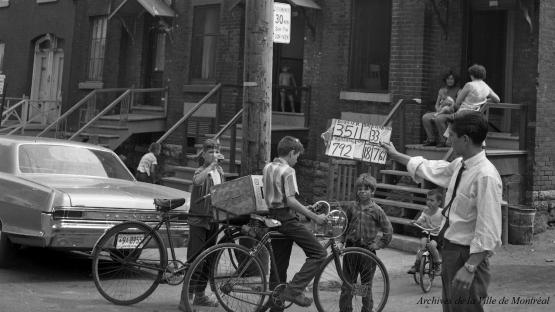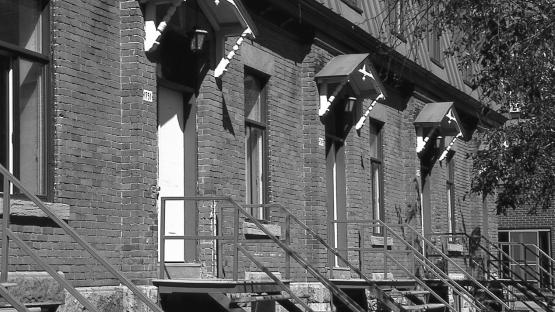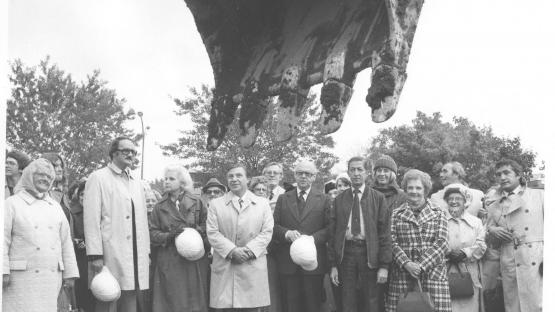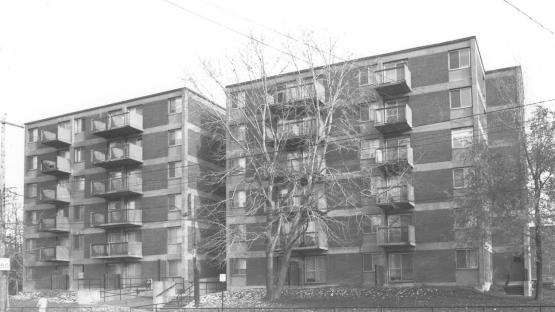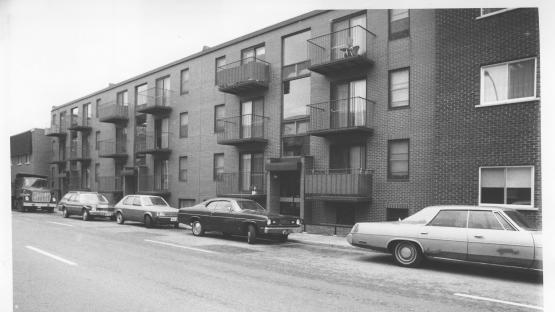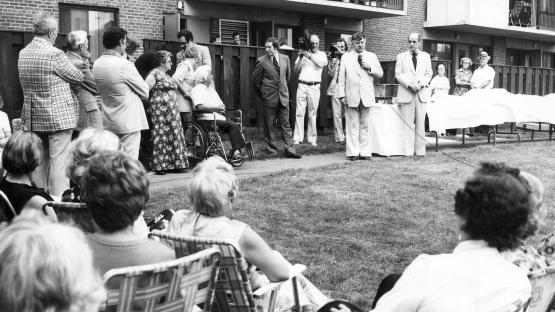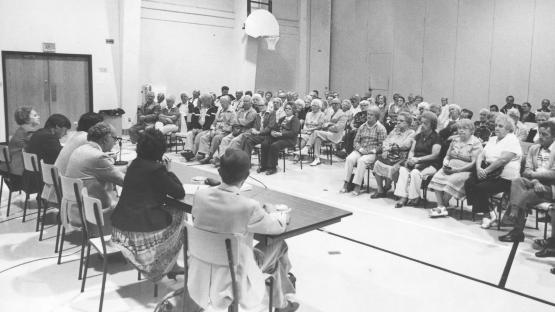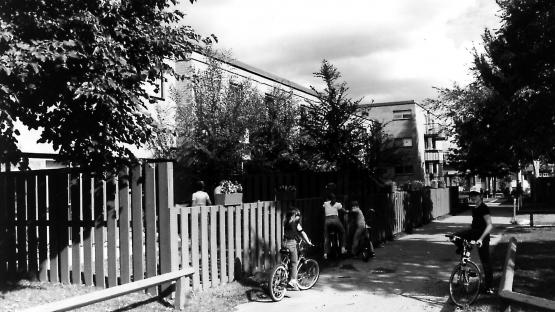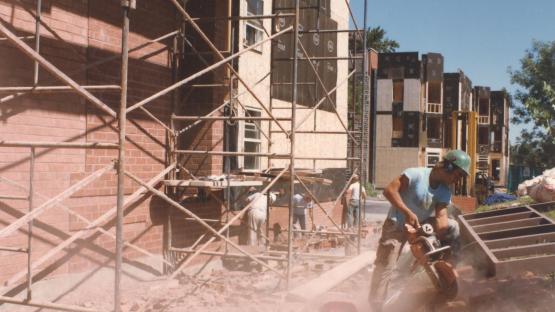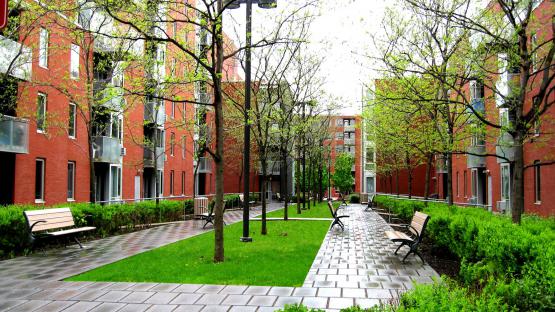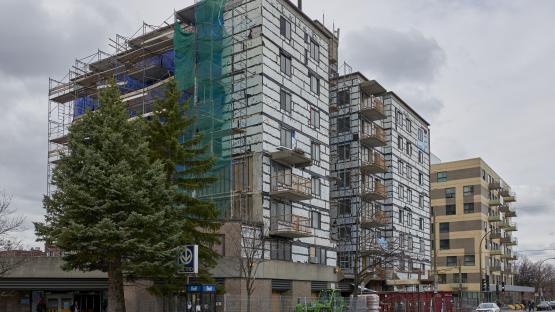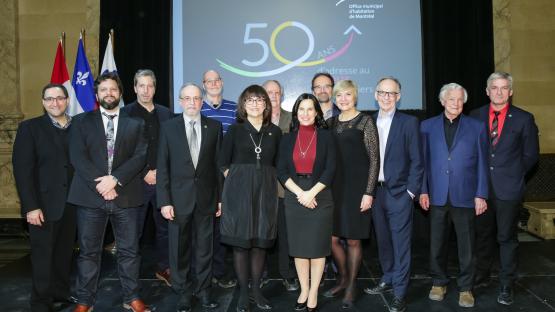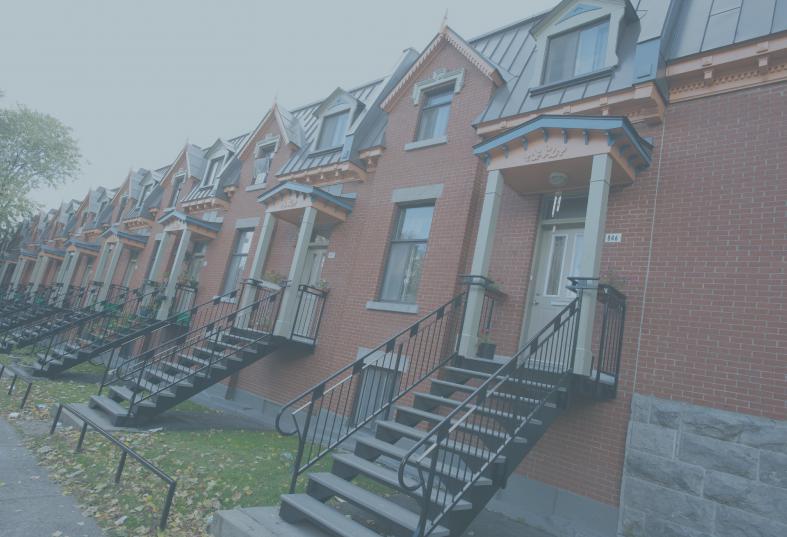
The OMHM: Housing Montreal families since 1969
1967
The government of Quebec adopted the Act respecting the Société d’habitation du Québec (SHQ). The SHQ’s role was to enable cities to obtain federal funds for urban renovation and for construction of low-rent housing; cities were authorized to create municipal housing offices.
The City of Montreal set up a Housing Department, which was originally responsible for three programs: restoring housing, urban renovation and low-rent housing. This department assumed responsibility for the project at Îlots Saint-Martin.
1969
The city set up the Office municipal d’habitation de Montréal (OMHM), which was the first municipal housing office in Quebec and is still the largest today. The director of the city’s housing department, Guy Legault, was appointed to lead the new office (and remained director until 1979).
The OMHM completed construction of the Îlots Saint-Martin complex, which was the first low-rent housing in accordance with Quebec legislation, and one of the largest comprising 313 housing units. In the subsequent years, the OMHM constructed more low-rent housing to rehouse families whose homes had been demolished in the wake of large urban projects (for example, the Radio-Canada tower, the Ville-Marie Expressway, etc.).
1971
The OMHM constructed the first tower for seniors: Habitations Dublin-Fortune located in Pointe-Saint-Charles. From that time, the trend was towards constructing separate buildings for families and seniors.
The Lachine Municipal Housing Office constructed Place Lachine, the largest low-rent housing complex on the island of Montreal comprising 399 units. (The Jeanne-Mance housing complex, comprising 788 units, is not a low-rent housing unit as per the legal definition.)
1972-1993
On the island of Montreal, 14 municipalities outside the City of Montreal established municipal housing offices.
1982
The SHQ abolished the rent ceilings in low-rent housing, an act that triggered an exodus of workers, who accounted for a significant proportion of their tenants. As rents were now set at 25% of the gross household income, these workers would pay more in low-rent housing than on the private market.
1990
The SHQ adopted new regulations governing the allocation of housing for the most disadvantaged people. Based on the previous criteria, the municipal housing offices were able to strive for a certain degree of social diversity. In these days, in Montreal, the OMHM aimed to allocate 35% of housing for families to workers with families. These new regulations had the inevitable effect of forcing out workers, a process that had already begun after the abolition of the rent ceiling in 1982.
1994
The federal government withdrew its funding for the low-rent housing. Until then, they had been providing 65% of funds needed for construction, with the remaining funds coming from the government of Quebec (25%) and the municipality (10%). From that time, the OMHM stopped constructing any new low-rent housing units, and merely managed the existing housing stock.
2002
All municipal housing offices on the island of Montreal were amalgamated. The OMHM was able to draw on major new housing stock: more than 3,000 housing units, 3,300 tenants, 11 tenants’ associations, 5 community organizations and around 80 new employees. Although some of the municipalities on the island left the amalgamation in 2006, the municipal offices remained together.
The OMHM undertook construction and acquisition of affordable housing as a result of the Logement abordable Québec program (LAQ) and the City of Montreal’s opération Solidarité 5000 logements. Affordable housing managed by the OMHM comprises 10 seniors’ residences, making up the ENHARMONIE network with a total of 1,259 housing units, as well as some 400 other housing for families, accounting for a total of 1,682 units in 2010.
2007
The OMHM acquired the Benny Farm complex, comprising four residential buildings with a total of 237 housing units. Built by the Canada Mortgage and Housing Corporation (CMHC) and the Canada Lands Corporation (CLC) in 1997 and 2000, these modern, accessible homes were originally designed to house Second World War veterans, who lived in the original buildings built by the federal government in 1947. The OMHM bought the complex to increase the number of apartments available to Montrealers on waiting lists for social housing. This was the first time that the OMHM acquired buildings without the support of government purchasing, renovation or operating programs, which was a significant turning point in its history.
2010
The LAQ program ended. At its end, the OMHM had 349 affordable housing units and 1259 affordable housing units with services for seniors in the 10 buildings belonging to the ENHARMONIE network.
The OMHM took over management of Manoir Roger-Bernard, which had been managed by a not-for-profit until that date. In 2013, two other buildings were added to the housing stock, which brought the total low-rent housing units to 20,810 units.
2015
The OMHM implemented its third strategic plan. The organization’s mission, which has evolved over the years, is now: “Improve the living conditions of low-income individuals and families by offering quality services and housing, while fostering their power of influence and action.”
More than 25,000 households are waiting for low-rent housing. This significant number will reduce significantly to around 23,000 in fall 2018.
2019
On February 27, 2019, the City of Montreal marked the 50th anniversary of the OMHM in the presence of some 160 guests (OMHM employees and tenants, numerous partners and funders) in the lobby of City Hall. It is also one of the last events to be held in this place before major renovations. Under the theme 50 ans d’adresse au cœur des quartiers, the OMHM also celebrates this anniversary at the Community and Volunteer Action Recognition Ceremony, at the cocktail reception of the OMHM Foundation (now La Clé Foundation). and at a special event for its staff and retirees at Marché Bonsecours.
2022
The completion of Îlot Rosemont, a flagship project for the OMHM, concludes 2022. The eight- and ten-storey building, which surrounds the Rosemont metro station and encompasses the STM bus loop, includes the new OMHM Administrative and Services Center and the Résidence Des Ateliers. The latter is the 11th residence of the ENHARMONIE network and the first smoke-free residence of the network. It includes 193 housing units with services for seniors. Housing applicants and other partners, suppliers and clients are now welcomed at 400, boulevard Rosemont, where some 300 employees work.

